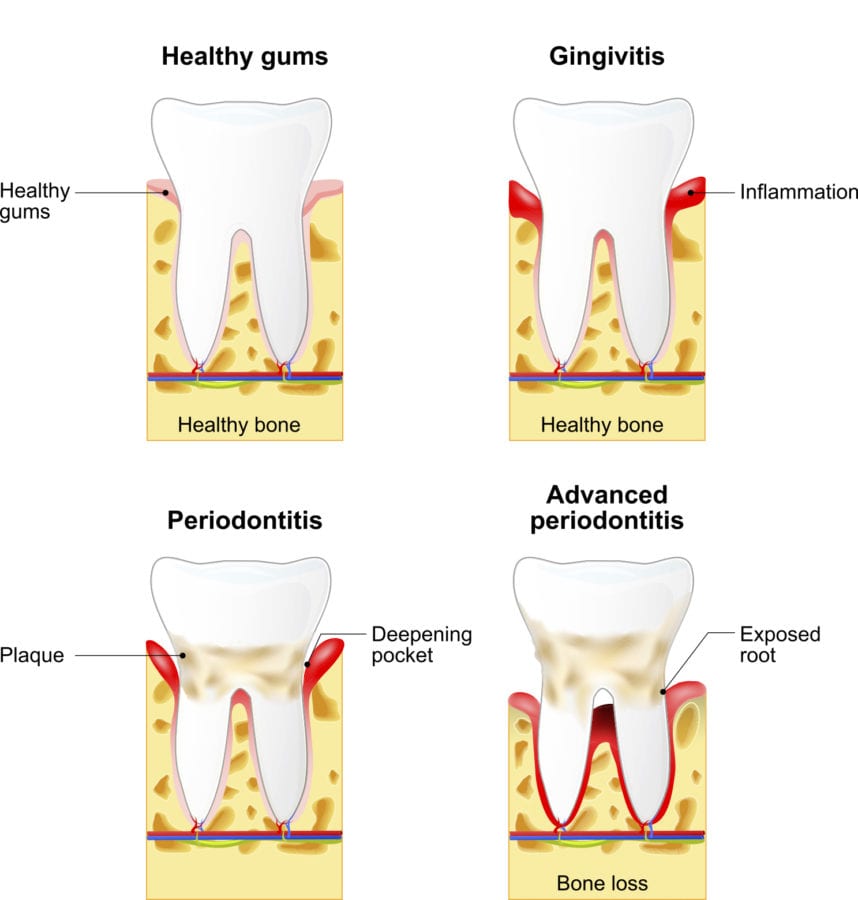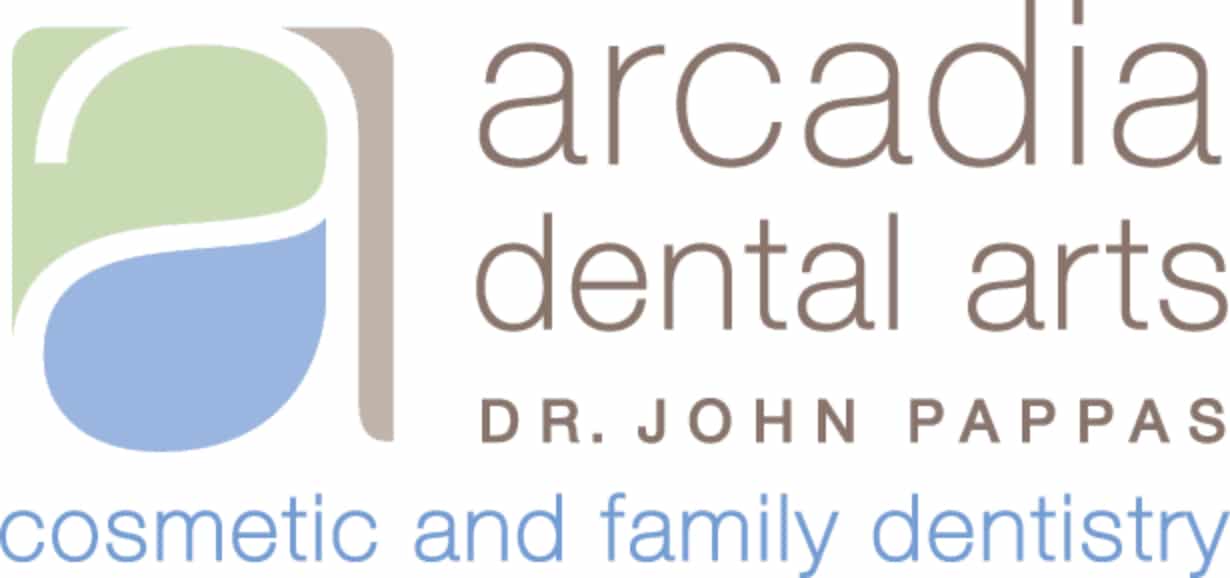Bleeding gums are not a normal part of a healthy mouth. In fact, they’re one of the earliest signs of gum disease. According to the CDC, nearly half of all adults aged 30 and over show signs of gum disease.
If you are concerned that you may be suffering from gum disease in Phoenix, AZ, call to schedule a consultation with Dr. Pappas today!

What Is Gum Disease?
When plaque accumulates on and around the teeth, it can lead to an infection of the gums, also referred to as gingivitis. In its earliest stages, gum disease can be treated and completely reversed. Once the disease progresses the damage can become permanent. This is why early diagnosis and treatment is so important.
Gum disease is one of the leading causes of tooth loss in adults.
What Are the Stages of Gum Disease?
Gum disease is generally sectioned into four stages:
- Gingivitis. This first stage is inflammation with very little, if any, gum recession.
- Initial periodontitis. This infection affects deeper periodontal structures, such as the ligament that stabilizes teeth to the bone.
- Mild periodontitis. A more advanced infection, this stage can include bone loss in the teeth's root surfaces.
- Progressive periodontitis. This more severe form of gum disease involves significant bone loss in which teeth shift or become loose. It can be painful to chew.
What Causes Gum Disease?
Poor oral care habits are the primary cause of gum disease. Without strong brushing and flossing practice, plaque can build up on teeth at the gumline. Our mouths are home to many bacteria that combine with mucus and tiny particles of food to form a sticky, colorless substance we call plaque. Brushing and flossing are the necessary habits to remove this substance from the mouth. When plaque is not adequately removed, it hardens to a calcified substance called tartar. Tartar cannot be removed with a toothbrush nor with flossing. This hardened substance must be removed by the dentist, who uses a special instrument to carefully break apart the tartar without damaging the tooth. In addition to poor oral care, a person's risk of gum disease may be influenced by health and lifestyle factors. Examples include smoking, dry mouth, diabetes, and certain medications.
What is a Perioscope?
A Perioscope is a tiny fiberoptic camera that we use to visualize tartar deposits that are attached to the tooth root, far below the gumline. These are the most damaging tartar deposits. They are in very close relationship to the tissue and bone where it attaches to the tooth root. If this tartar is not fully removed, bone loss and advancing gum disease is inevitable. In the past, dentists and hygienists would remove these tartar deposits by feel only. We weren't able to see the tartar so we would have to rely on our sense of touch to determine whether the root was clean or not. Unfortunately, this technique could result in only partial healing as some tartar deposits may be left behind. Now, with the use of a Perioscope, we have full visualization of the tartar deposits and are able to remove it completely!
What Is the Recovery Like for Laser Gum Treatment?
Laser gum treatments are advantageous in part because the procedure is very low on the scale of discomfort. Patients usually tolerate their treatment well without the use of an anesthetic that numbs the gums. Tissue also tends to heal more quickly after laser treatments than standard gum surgery. That said, the gums still need to heal, and oral care after the procedure is integral to how long it takes for this to happen. During the first week of recovery after laser gum treatment, tiny clots may form over the affected area. These must not be dislodged, if at all possible. One way to prevent breaking a clot loose is to eat a soft food diet for about one week. Reducing the amount of chewing limits friction or movement against the clots. Brushing and flossing are important after dental treatment so should continue twice a day, but with care to avoid touching toothbrush bristles directly to the gums that have been treated. Instead, patients can place bristles below the treated area and gently, slowly, roll them up toward the tooth. While it can take months for the gums to fully heal, depending on the extent of gum disease treated, patients may begin resuming most normal habits a week to 10 days after their procedure.
What Happens if Gum Disease Is Not Treated?
Based on the term for this infection, gum disease, one might think that the condition is limited to the soft tissue around teeth. Gum disease is not always a full-mouth problem. It may initially develop around one or just a few teeth. Without proper care, though, the bacteria that contribute to the disease process thrive and find their way deeper beneath the gums. Eventually, gum disease can affect the periodontal ligament and jawbone that are responsible for stabilizing teeth. Untreated gum disease can result in gum recession, pain when chewing, tooth sensitivity, bad breath, and tooth loss. The bacteria involved in gum disease can also travel to other parts of the body. Current research suggests that gum disease can increase a person's risk of cardiovascular disease, some types of cancer, respiratory illnesses, and, for women, preterm labor.
It must be repeated that gum disease is a preventable and very treatable condition. The risks of complications stemming from gum disease can be mitigated with good oral care habits and routine dental exams and cleanings.
How to Prepare for Gum Disease Treatment?
Before performing treatment for gum disease, your dentist may prescribe antibiotics for you to begin days prior to your appointment. Talk to your dentist about precautions they recommend based on your situation and general health.
Will Gum Disease Go Away on Its Own?
This depends on how bad the oral infection has gotten. If you receive proper care during the first stage of disease, gingivitis, you may avoid the more extensive consequences of gum disease. However, once the periodontal area has become infected, it is necessary to receive corrective treatment to eliminate the infection and then to receive periodic treatment as needed to complement your strict daily oral care regimen.
How Do I Know If I Have Gum Disease?
One of the reasons that gum disease often progresses to advanced stages before treatment begins is because it can often be painless in the beginning.

Gum Disease Symptoms
- Bleeding gums
- Swollen, red and tender gums
- Bad breath
- Loose teeth
- Gums pulling away from the teeth
- Changes in the bite
The best way to ensure that gum disease doesn’t go unnoticed is to be vigilant about twice a year professional cleanings and exams. This enables us to:
- Monitor your gums
- Clean off built-up plaque
- Help you spot problem areas
- Keep an eye on anything that looks suspicious
Gum Disease Treatment
The traditional treatment for advanced gum disease at many dental practices is surgery. At Arcadia Dental Arts we invest in leading technology to treat advanced gum disease effectively without surgery whenever possible. These alternative treatments include:
Laser Treatment
Instead of jumping straight to invasive surgery, Dr. Pappas prefers laser gum disease treatment to remove bacteria and diseased tissue. This allows the gums near the roots of the teeth to heal and regenerate quickly.
Some of the benefits of laser gum treatment are:
- No anesthetic is needed
- Precision of lasers saves healthy gum tissue
- Less invasive
- Healing and recovery time is short
Perioscopy
Using a miniature endoscope, or lighted camera, Dr. Pappas can see the details of each tooth and area of gum at over 48 times its actual size. This detailed magnification allows for him to see below the gum line, something that was never possible in the past without invasive surgery. Dr. Pappas is one of only a few dentists in the Phoenix area who is trained in this cutting-edge technology that has led to a huge improvement in the success of treatments for those suffering from advanced gum disease.
Gum disease is a slow, chronic and often silent disease. Most patients aren’t even aware they have it until its progressed into the advanced stages. By the time symptoms become evident it’s often already past the point of complete healing.
This is why at Arcadia Dental Arts we focus on early prevention, diagnosis and treatment. Our strong emphasis on patient education is a huge part of successful prevention and early diagnosis.
For more information on gum disease, or to schedule a cleaning and exam, call us today at 602.957.9643.
What People Say About Us!
Dr.Pappas and his staff are amazing! Very thorough, comprehensive, full-service care. Wonderful bedside manner – best dentist my husband and I have been too.
Click here to read more reviews.


